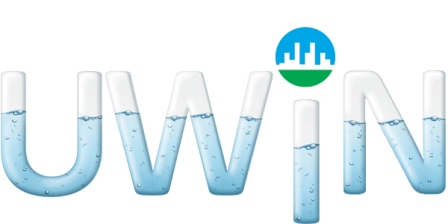Project B1-1 (Texas A&M): Urban Water Infrastructure Resilience
Ali Mostafavi, PhD
Texas A&M University
Department of Civil Engineering
In order to evaluate innovative water strategies before investments are made, analysis of long-term resilience of urban water infrastructure is needed. The objective of this study is to analyze the long-term resilience of urban water infrastructure systems under different stressors (e.g., climate change impacts, population growth, and aging infrastructure).
The approach is to create a dynamic simulation model capable of capturing the attributes of physical infrastructure (e.g., pipe age, material, length) as well as decision-making processes of utility agencies in order to simulate the effectiveness of different strategies in improving the resiliency of water infrastructure.
The model examines several measures to generate a service reliability score including average condition, annual network leakage, annual energy use, annual network breakage and level of service.
DATA NEEDS
A detailed list of specific data needs will be provided to case study utilities.
- Aggregated urban water infrastructure inventory (pipe, pumps, tanks, etc.)
- Location of treatment plants and pump station
- Topology of water distribution network (GIS Layer)
DATA USE
Data will be used as inputs to water infrastructure model to simulate the long-term performance and resilience of infrastructure networks.
PROJECT KEYWORDS
- Physical Infrastructure
- Decision-Making Strategy
- Sustainability
- Urban Planning
- Resilience Performance
- Network Costs
- Energy Use
This project will analyze the resilience of water infrastructure system to climate change impacts. The strategies identified in B1-1 will be modeled in order to simulate the long-term resilience performance (e.g., system reliability, pipe break frequency, and leakage) of water infrastructure under different scenarios.
The results will be integrated with B1-2 to compare the life cycle impacts and resilience of infrastructure under different strategies and analyze trade-offs. The outputs of the model will consider various measures such as:
- Network Costs
- Reliability
- Performance Condition
- Energy Use
In addition, the analysis will capture the impacts of abrupt disruptions (e.g., hurricane or earthquake) in order to simulate the impacts of these extreme event scenarios on water infrastructure.
Dynamic Simulation Model
The dynamic simulation model combines the attributes of physical infrastructure with the decision-making processes to simulate the effectiveness of different strategies in improving the resiliency of water infrastructure.
Modeling of physical infrastructure will consider different factors such as the decay of pipeline networks, likelihood of breaks, and the amount of leakage in the network. The decision-making process component will examine different renewal strategies, revenue allocation mechanisms, capital and operational expenditures, and risk tolerances.
The physical and decision elements will be modeled through the use of mathematical, stochastic, and decision-theoretic methods. Different strategies, such as dual water supply and distributed treatment systems, will be modeled and the resilience performance of each strategy will be analyzed. The outputs (see the figure below) of the model will consider various measures such as network costs, reliability, performance condition, and energy use. In addition, the analysis will capture the impacts of abrupt disruptions (e.g., hurricane or earthquake) in order to simulate the impacts of these extreme event scenarios on water infrastructure.
Journal Articles
Dargin, J., Berk A., and Mostafavi A. (2020). Assessment of household-level food-energy-water nexus vulnerability during disasters. Sustainable Cities and Society, 62, 1-23. https://doi.org/10.1016/j.scs.2020.102366
Rasoulkhani, K.; Logasa, B.; Presa Reyes, M.; Mostafavi, A. Understanding Fundamental Phenomena Affecting the Water Conservation Technology Adoption of Residential Consumers Using Agent-Based Modeling. Water 2018, 10, 993. https://doi.org/10.3390/w10080993 Status = Published Acknowledgement of Federal Support = Yes; Peer Reviewed = Yes
Rasoulkhani, K. and Mostafavi, A., 2018. Resilience as an emergent property of human-infrastructure dynamics: A multi-agent simulation model for characterizing regime shifts and tipping point behaviors in infrastructure systems. PloS one, 13(11), e0207674. https://doi.org/10.1371/journal.pone.0207674 Status = Published Acknowledgement of Federal Support = Yes; Peer Reviewed = Yes
Rasoulkhani, K., Mostafavi, A., Reyes, M., and Batouli, M. (2020). “Resilience Planning in Hazards-Humans-Infrastructure Nexus: Simulation-based Exploratory Assessment of Coastal Water Supply Infrastructure Adaptation to Sea-level Rise,” Environmental Modeling and Software, https://doi.org/10.1016/j.envsoft.2020.104636
Rasoulkhani, K., Mostafavi, A., Sharvelle, S., and Cole, J. (2019). “Resilience-Based Infrastructure Planning and Asset Management: Study of Dual and Singular Water Distribution Infrastructure Performance Using A Simulation Approach.” Sustainable Cities and Society, Vol. 48, 101577, https://doi.org/10.1016/j.scs.2019.101577
Updated: May 2021
Dissertations
Rasoulkhani, Kambiz (2020). Assessment of Urban Water Infrastructure System Resilience. Ph.D. Dissertation, Texas A&M University.
Related Materials
- Research Overview Webinar (2018)
- UWIN B1-1 (TAMU) Project Overview
- UWIN B1-1 (CSU) Project Overview
- Integrated Urban Water Model User Guide
 Ali Mostafavi, PhD – Principal Investigator
Ali Mostafavi, PhD – Principal Investigator
Assistant Professor
Zachary Dept. of Civil Engineering
Texas A&M University
Voice: (979) 845-4856
Email: amostafavi@civil.tamu.edu
Dr. Mostafavi’s research interests focus on solving the challenges at the interface of the infrastructure systems, economy, environment and society. These problems are often large in scale and multidisciplinary, thereby requiring solution concepts that consider engineering and science simultaneously. Specialties include: Infrastructure-Energy-Environment nexus analysis, Sustainability and resilience of infrastructure systems, complex system simulation, risk analysis and modeling, financial analysis and modeling, business strategy, innovation assessment, policy analysis, decision making, and construction management.
Sybil Sharvelle, PhD – Co-Principal Investigator
Associate Professor
Civil and Environmental Engineering
Colorado State University
Voice: (970) 491-6081
Email: sybil.sharvelle@colostate.edu
Dr. Sharvelle has nine years of experience working on graywater projects. Her graduate studies were funded by NASA to optimize biological waste processing systems that would treat graywater with the end goal of potable reuse. The waste treatment concept employed entailed separate source collection and treatment of graywater, urine, and fecal material. Dr. Sharvelle’s experience in closed loop recycling of resources is very valuable for implementation of sustainable development concepts for urban water management. Dr. Sharvelle is currently working on sustainable urban water management including graywater reuse, reclaimed water reuse, development of models to estimate water savings associated with urban water conservation practices. Dr. Sharvelle also has several years of experience working on waste conversion to methane through anaerobic digestion.
Graduate Students
Jeanne Cole, PhD Candidate – Research Scientist
Colorado State University
Civil & Environmental Engineering
Email: jeanne.cole@colostate.edu


